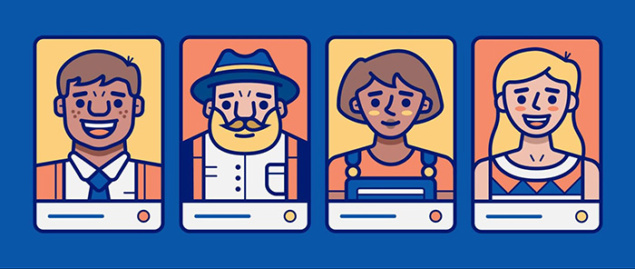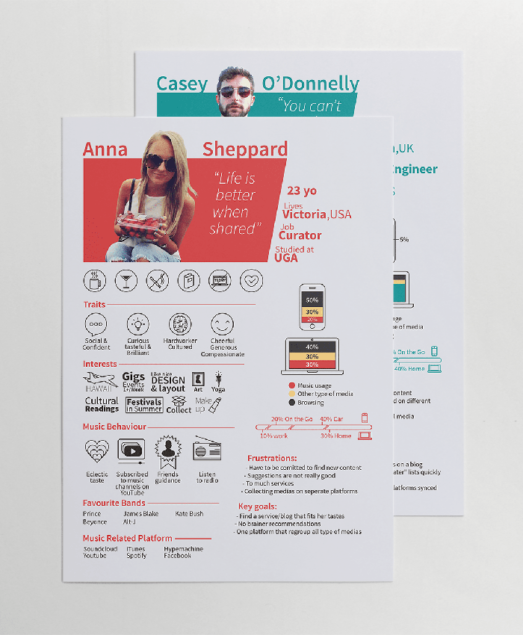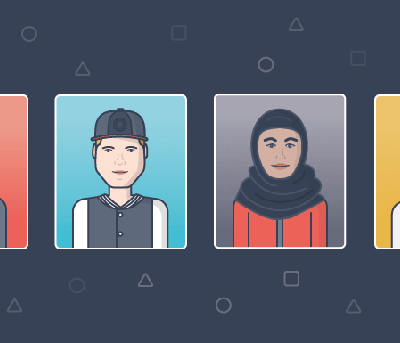If you want your brand to succeed, learning as much as possible about your target audience is absolutely crucial. Otherwise you’ll be reduced to making decisions on a hunch, which is rarely (if ever) a good strategy in the long run.
That being said, entrepreneurs often feel like they know their audience and what it wants. But only rarely do they actually know it.
An in-depth understanding of what makes your prospective customers tick may include things like age, gender, location, income, education level, interests, pain points, goals, preferred social media platforms, decision-making power, commercial value, social status, and much more. Phew, that’s quite a list.
To boil this all down into something manageable, marketers use personas – also known as user personas, customer personas, or buyer personas. These are a great tool for putting together the data you’ve collected in a vivid way. Best of all it makes product design and marketing campaign development easier.
Today we’re going to find out how it’s done, and see 10 examples of top customer personas.
What is a persona?
A persona is a semi-fictional representation of your target customer. Or, to put it another way, it’s a kind of composite “image” or summary of the different characteristics of your audience.
Despite being more or less clearly defined, personas represent not so much real as virtual people. They are approximations of actual customers that can help to guide your decision-making.
Having a human face and profile attached to user data often makes it much easier to step into your customers’ shoes and understand what kinds of products or services they need. And this makes it easier to figure out what types of messaging they’re most likely to respond to, and so on.
Why use personas?

There are many benefits to using personas for your e-commerce business. They can be roughly divided into four distinct categories:
#1. Business-wide consistency
Having a number of buyer personas distributed to each member of your organisation will make sure that everyone is on the same page. Personas can help you ensure that employees have a shared and specific understanding of each target group, and work together in unison.
The trick is to make it clear to everyone that buyer personas are not something “extra” or unimportant. Instead, they are the result of comprehensive research and development, and should be the cornerstone of product discovery and marketing.
#2. Real knowledge of customer base
The data that goes into your user personas should tell you quite a bit about the ways in which your prospective customers behave:
- where they get their information,
- what types of establishments they frequent,
- which social networks they prefer, and so on.
Having this information put together in a handful of vivid user personas can be tremendously helpful in creating strategies for promoting your products and services.
#3. User-centric design and marketing
Coming up with new ideas for your business can be really difficult if all you have is raw data and dry stats. How do you know if a product you’ve been bandying about during brainstorming sessions is really something that your customers want?
The insights provided by personas can make the process much smoother, not least because they put a face to the data. This encourages you to think about real people and their needs.
#4. Superior market positioning
If you’ve been developing your products and services by reference to a set of well-researched user personas, you should also have an easier time when it comes to positioning. It will help you answer questions like:
- Who should and who shouldn’t learn about your new app first?
- What is the best time to release information, and how much?
There are countless questions to address when it comes to positioning, and most of them can benefit from having realistic profiles of your target customers to hand. You’ll make decisions faster and you’re more likely to make the right call.
How many personas do you need?
It may seem like the more personas you create, the more of your audience will be covered. But that’s not how it works. Sure, you’ll probably need more than one persona. But above all you should be focusing on quality over quantity.
For most purposes, four primary personas should be enough – any more and you’ll start noticing that each new persona is just a variation of one that already exists.
The point of creating personas is to gain insight into the bulk of your audience. This means that some customers will inevitably fall through the cracks – and that’s perfectly fine. Just make sure the majority is covered and your customer personas will be doing their job.
With this in mind, you might want to apply the Pareto Principle here. This is when you focus on the 20% of your audience that represents 80% of your revenue. This is because complicating the persona development process to include each and every customer type in your audience is likely to bring more confusion rather than clarity. So zoom in on the ones who account for the most amount of sales and start there.
How to create a persona?
OK, we know what personas are and why you should have them. So it’s time to make your own. Here are 3 simple steps to doing so.
Step 1 - Research your target audience
The first thing you’ll need to do is research your target audience. The specific elements to include in the persona will vary project to project. But generally speaking, you should at least consider the following characteristics:
- Age
- Gender
- Language
- Interests
- Spending pattern
- Purchasing power
All of this information can be collected using Google and social media analytics tools, as well as by taking a close look at your own customer database.
If you still need more information, do some digging and find out which social media platforms your customers prefer. Google Analytics and tools like Keyhole will be your best friends here. And study what your competitors have already discovered - check out Feedly, Buzzsumo and similar platforms to do this.
Step 2 - Identify goals, pain points, and solutions
- What goals do your customers have?
- What kinds of problems do they face in achieving them?
- Are there any specific patterns in how they deal with them?
- What do they need to overcome the barriers that stand in their way?
Think of goals as something positive – what a person wants, and pain points as something negative – what prevents them from getting it.
Whether the goals typical of your customers are related to what your company does or not, the purpose of gathering this information is simply to get to know your audience. You don’t need to immediately start worrying about how you could solve every problem.
You can uss social listening tools like ReviewTrackers, Reddit Keyword Monitor, Mentionlytics. You might also want to have a chat with your customer service and sales teams which, no doubt, can provide you with lots of valuable info.
Once you’ve got enough data, you can start thinking about the ways in which you could be of service. Try to focus not so much on specific products capable of doing specific things, as on how your brand could improve the lives of your customers.
Step 3 - Create your buyer personas
With all the data now at your fingertips, all that remains is to look for recurring patterns, identify the most relevant ones, and create a semi-fictional persona for each.
For instance, after wading through your data, let’s say that you’ve found a large cohort of urban women in their mid-20s to early 30s. They work in IT, prefer riding bicycles to driving or taking the bus, and own dogs.
Now you’ll want to give your buyer persona a name, a job title, and whatever else you think relevant, not forgetting to include their goals and pain points.
As mentioned previously, the amount of information you include will depend on your aims. For example, if you simply want your employees be constantly reminded that customers are real people rather than data points, a lean persona will suffice (such as the purely image-based one you’ll find below). If, on the other hand, you’re planning a promotional campaign, a more detailed persona will be in order.
Top 10 persona examples
OK, let’s take a look at some persona examples and breakdown what’s good about them.
#1. The web developer
Among other virtues, this persona is great because of its simplicity. It gives you just enough information to keep your mind focused, but not too much where it becomes confusing.
Another thing of note is the sliders used for personality traits, which is neat. And the fact that we’re looking at “Rory” rather than Mr Programming McCoder gives it a nice human touch.
#2. The project manager
While slightly busier than the previous one, this persona is great because of its bold and bright colour scheme, which makes it easy to digest. The fact that goals, motivations and frustrations take centre stage is also key, and the plentiful graphical representations make for a quick overview.
#3. The reader
The main distinguishing feature of Nerdy Nina’s profile – beyond the neat way of providing an overview of her core traits in the image itself – is the “Favorite Books” section. Including examples of well-known products that your customers like enables a whole range of credible assumptions and associations.
#4. The freelancer
Isaac Rice is a freelance video producer with a set of very specific goals and pain points. These give us quite a bit of insight into what kinds of products or services he might find useful. This persona contains rather more information than the previous ones, but that could be a benefit depending on the project.
#5. The influencer
Here we have another excellent persona. It has an attractive, high-contrast color scheme and large image that naturally directs the gaze, encouraging you to think of your target customers as real people.
Each section is clearly labelled and there’s plenty of graphical elements like icons, numerical representations and bar charts that neatly complement the text. And the text itself is clear and concise.
#6. The health-conscious mom
This persona template makes it very clear what’s on the mind of this 32-year-old mom, and what she’s like as a person.
A quick glance already tells us that she struggles more with time management than with money. And, judging from the brand logos, we understand that she’s modern, fashionable, and likely open to new experiences.
#7. The aviation analyst
What’s clear from the get-go about this persona is that it took a lot of quantitative research to compile it.
The wealth of information is nonetheless presented in a digestible manner with lots of colour differentiation, bar charts and other elements. It was clearly necessary to have very detailed data for targeting a narrow range of customers, but they’ve managed to present it in a clear and simple way.
#8. The alternative consumer
Not all personas have to be text-based! Unique arrangements based around images, such as the one you see above that was made by Jason Travis, can sometimes do a better job than more traditional personas.
Pictures can tell a whole lot about someone’s personality, goals, and preferences (in some cases more than regular text). Furthermore, images can be useful for brainstorming and free-association sessions.
#9. The curator

This persona template really excels at maximising creative, memorable visuals and associating them with important information.
The minimalist layout and bright colours against a white background combine to really bring out the key sections. Meanwhile, the colour-graded breakdown of device usage purposes completes the overall music-related theme.
#10. The customer
Who doesn’t like a colourful infographic? Combining eye-popping images with stats and text is a winning combination for almost any type of persona.
Meet Mike features light tones and bright colours, as well as clearly identified key characteristics, further backed up by numbers.
The takeaways
As these 10 examples show, customer personas are all about turning complex research and analysis into clear, understandable messages that all of your team can learn. When you’re building your personas, spend time thinking about colour, layout and design. The more you invest here, the more likely you and your team are to actually refer to your personas on a regular basis (some more knowledge of color psychology in branding would help with this process).
And, as we’ve mentioned, when you and your team use your personas regularly, you’ll benefit from:
- Improved audience targeting,
- Consistent brand building that encourages loyalty,
- And better messaging that will boost engagement and conversion.
FAQ
What is a persona?
A persona is a tool used by companies. The information they’ve collected about their existing or potential customers is aggregated or synthesised into a number of realistic human profiles.
What are the benefits of using a persona?
Because it is a summary of the various characteristics of real people, a buyer persona can help you gain some clarity about what your target audience is really like (which isn’t necessarily evident from raw data and stats). It will help you to prioritise the needs and desires of actual people. This can be really useful when brainstorming new products or services, and devising promotional strategies.
How many personas do I need?
The specific number of personas you need will depend on their intended users, the overall purpose of making them, and many other factors. Generally speaking, though, something like four primary buyer personas is a good rule of thumb – this should cover the most important groups of your target audience without overwhelming you with detail or wasting too much time on research.
How to make a persona?
The process of making a persona can be roughly divided into three distinct steps:
- Research your audience using Google and social media analytics tools, collecting a wide range of relevant data, such as age, gender, language, spending pattern, etc.
- Identify goals, pain points, and potential solutions – this will feed into the resulting personas you create. Based on the data, try to determine what your customers need or desire, what prevents them from attaining it, and how you could help them overcome whatever barriers are in their way.
Analyse the data that you’ve collected and write down any patterns that you see emerging from it. For example, you may notice a cohort of, say, young moms who are pursuing careers in business, own apartments downtown, and are looking for organic goods for their small children. This could be a persona. In most cases, the amount of information to include shouldn’t be very much more than a profile on, e.g., a dating site.




